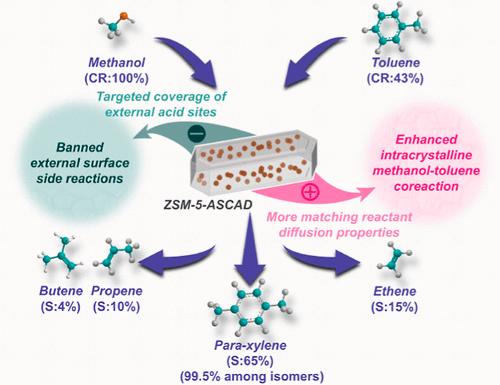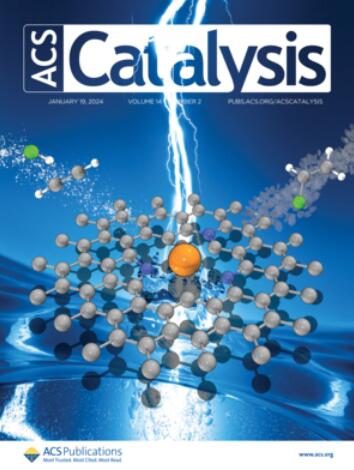Targeted Modification of Zeolites for Exceptionally Active and Selective Generation of PX and Light Olefins from Methanol–Toluene Co-Conversion
IF 11.3
1区 化学
Q1 CHEMISTRY, PHYSICAL
引用次数: 0
Abstract
External surface modification is an effective means of achieving selective production in the acid-catalyzed process over the zeolite. However, catalyst modification, including external surface modification, often fails to break the seesaw effect between the reaction activity and selectivity. In the present work, an acid site-targeted chemical adsorption deposition (acid site-chemical adsorption–deposition (ASCAD)) method is applied to precisely control the deposition of silica. The modified ZSM-5 (ZSM-5-ASCAD) shows notable improvements in shape selectivity and catalytic activity in methanol–toluene coconversion. The total selectivity of light olefins and paraxylene (PX) reaches 94%, and the proportion of PX among xylene isomers is 99.5%. Meanwhile, toluene conversion is maintained at 43%, which is much higher than that over ZSM-5 modified by the conventional chemical liquid deposition (CLD) method (18%). Applying multiple techniques, including time of flight secondary ion mass spectrometry for depth profiling, the zero length column method combined with infrared microscopy (IRM) for diffusion evaluations and isotope labeling technology to reveal the mechanism and reaction pathway, we confirm that the ASCAD method achieves a minimized silica deposition that precisely shields the acid sites on the external surface while introducing only a slight impact on the diffusion compared to the severe diffusion depression of the CLD method. ASCAD modification effectively suppresses unwanted and uncontrollable side reactions and maintains high reactant conversion simultaneously. This unique modification method minimizes the disparity in mass transfer capability between the reactant methanol and toluene, which has not been achieved with other modification methods before, leading to enhanced methanol–toluene coconversion within the ZSM-5 crystal and exhibiting promoted ethene production and super high PX selectivity at the same time. Targeted modification of the zeolite surface provides an effective approach to simultaneously enhancing the activity and shape selectivity of zeolite-catalyzed reactions.

求助全文
约1分钟内获得全文
求助全文
来源期刊

ACS Catalysis
CHEMISTRY, PHYSICAL-
CiteScore
20.80
自引率
6.20%
发文量
1253
审稿时长
1.5 months
期刊介绍:
ACS Catalysis is an esteemed journal that publishes original research in the fields of heterogeneous catalysis, molecular catalysis, and biocatalysis. It offers broad coverage across diverse areas such as life sciences, organometallics and synthesis, photochemistry and electrochemistry, drug discovery and synthesis, materials science, environmental protection, polymer discovery and synthesis, and energy and fuels.
The scope of the journal is to showcase innovative work in various aspects of catalysis. This includes new reactions and novel synthetic approaches utilizing known catalysts, the discovery or modification of new catalysts, elucidation of catalytic mechanisms through cutting-edge investigations, practical enhancements of existing processes, as well as conceptual advances in the field. Contributions to ACS Catalysis can encompass both experimental and theoretical research focused on catalytic molecules, macromolecules, and materials that exhibit catalytic turnover.
 求助内容:
求助内容: 应助结果提醒方式:
应助结果提醒方式:


